I was shaken awake in the middle of the night…‘You should go out and see the view before the clouds roll back in.’ I reluctantly crawled out of my warm sleeping bag, grabbed my down jacket and made my way down a small ladder from our sleeping platform above the main room. Despite it being 3am, being above the arctic circle means constant bright daylight. I stepped outside, blinked, and couldn’t believe my eyes. What I saw was incredible. A massive glacier right next to the mountain hut, winding its way down the valley which we had hiked up the day before in pea soup fog and drizzly rain. Gazing out, there was ice and snow as far as I could see.
We had been to some incredible places in Norway already, but this one clearly stood out. And when the sun finally broke through the remaining clouds a few hours later, the scenery looked even more majestic – rows and rows of spikey mountains disappearing into the distance.
Looking back now, a few weeks after the end of the trip, this was the moment that stood out on the trip for me. I’ll admit that at first I was reluctant to climb the mountain and Kirsty dragged me up. The rain and fog didn’t really encourage me to go head up high but the forecast was perfect so head up we did. My previous cycling holidays were mainly spent on tracks and roads, but this one was different. It was our first longer holiday together and as well as cycling, we took time to cook good food, find awesome places to camp, took a few days off to enjoy the mellow vibe of Henngisvaer and climbed mountains. The bike was a great vehicle to get to places and while we enjoyed the cycling, it wasn’t the only focus of the trip.
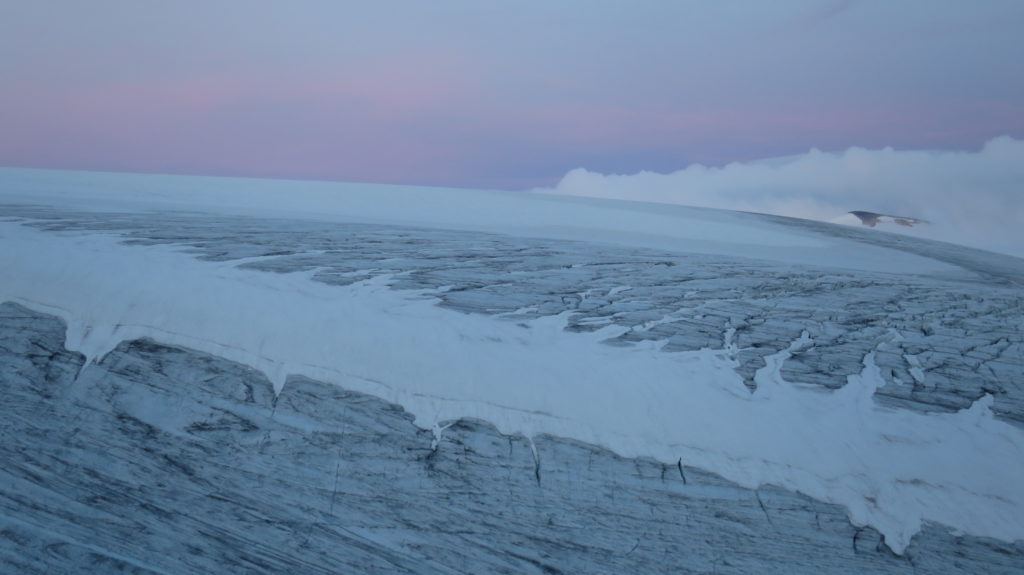
I met Kirsty this January and although we had done a bit of cycling together, we had never been on a tandem before. We both love extremes and as I was racking up more than 300km per day for the Nikwax Challenge in July, Kirsty took a well-earned rest in Tromso after 3 weeks of sailing in the high arctic and crossing the Barents Sea from Svalbard to Tromso on a small yacht. Our plans for the Norwegian part of the trip didn’t stretch further than ‘meeting up’ but Kirsty was planning while I was clocking up the Nikwax kilometres so when she asked me on the phone if I fancied hiring a tandem for the first few days of our trip I agreed straight away.
The first ride to our apartment after picking up the tandem at Tromso Outdoor on a Saturday morning was a rather scary experience for both of us. As we found out the hard way tandem riding needs a lot of coordination, especially when starting and stopping. There’s no other form of cycling that requires constant teamwork. As riding a tandem for the first time in the busy city centre wasn’t enough of a challenge, we soon loaded it up with two front and rear panniers, a tent strapped under the bars and our two climbing packs strapped to the back. This setup made it the heaviest bike I had cycled in a long time but considering that it was carrying the kit for both of us, we did a good job reducing ourselves down to the minimum we needed.
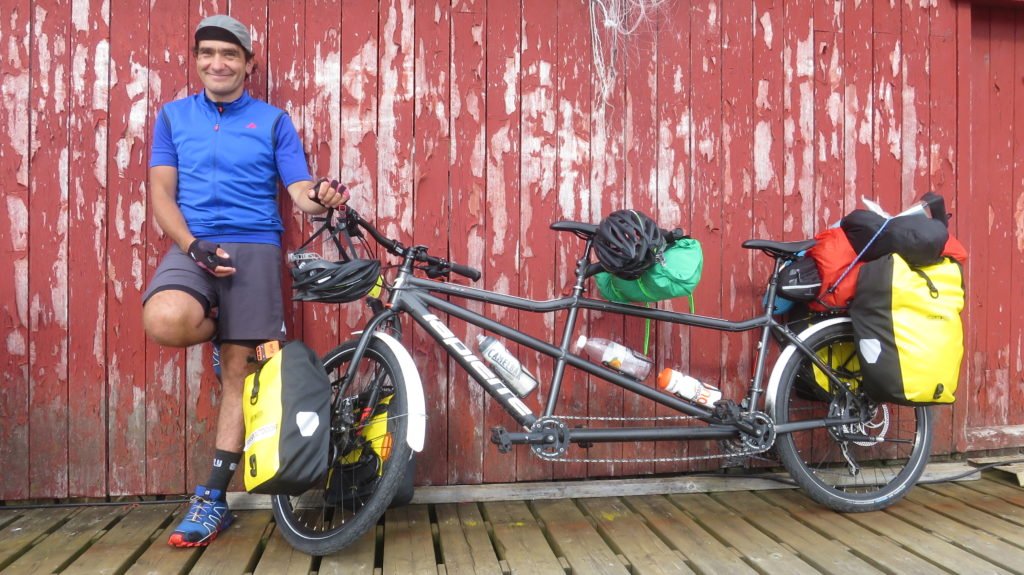
When we set off Kirsty and I had mixed feelings about what was to come as we wobbled our way out of town, heading west towards Senja. Norway’s second largest island is a perfect cycling destination, with steep mountains plunging deep into the ocean and narrow and surprisingly quiet, flat roads that twist and turn along fjords with crystal clear, icy-cold waters. A theme that would continue pretty much throughout the rest of our trip, but Senja, so far ignored by mass tourism, proved to the be the perfect place to start. Starting riding about 1000km above the Arctic Circle we enjoyed the midnight sun and the first of the 18 Nasjonale Turistveger , Norway’s Scenic Routes, packed with amazing views and stunning architecture along the way. Being an architect, Kirsty took great interest in the Tungeneset rest area and the grand vistas from the Bergsbotn viewing platform. Those superbly designed landmarks along the Nasjonale Turistveger are one thing unique to cycle touring in Norway and are also perfect for refuelling breaks.
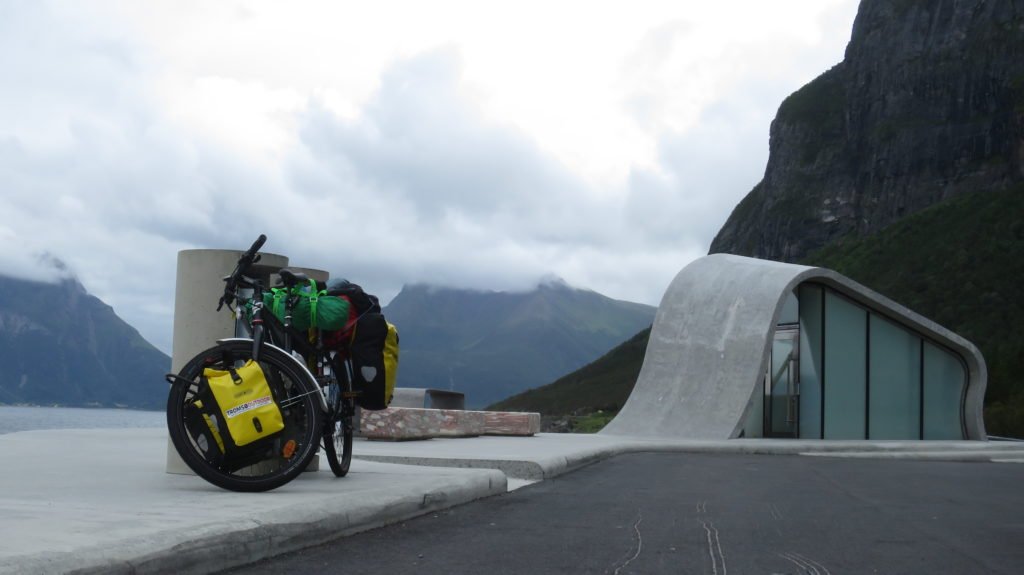
On our third night we stayed at Senjabu Hut, one of over 500 cabins managed by the Norwegian Trekking Association (DNT), scattered throughout the National Parks and other areas of great natural beauty. The cabins range from unattended self catered to fully serviced cabins with wardens and food provided. Joining the DNT for a year not only gave us a 50% discount on the nightly fee (about £10 for members), but also access to the key to unlock the hut.
After another ferry journey we continued our adventure on Vesteralen, the ‘Kingdom of the Whales’. With daily whale watching trips to see sperm whales, Andennes is a great location for whale watching, but our sights were focussed on an incredible spot to pitch our tent near Bleik, a few kilometres south. Like Senja, the archipelago of Vesterålen is a place characterized by contrasts with white beaches and craggy mountains making one of the most perfect camp spots. Most of our camp spots faced west so we could admire the beauty of the midnight sun reflecting off the sea. It didn’t get dark until we were back south of the arctic circle, several weeks later.
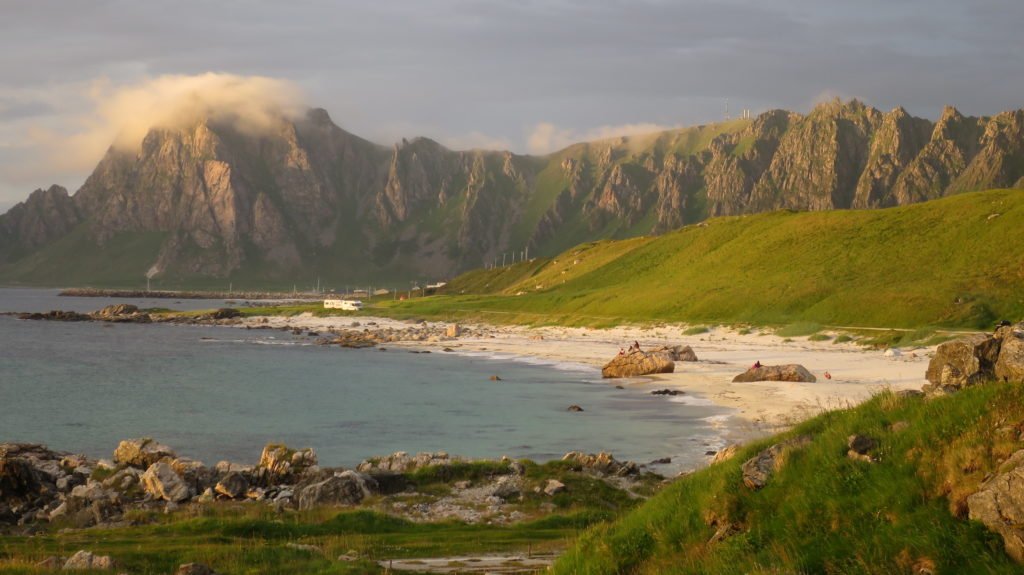
This journey wasn’t about covering massive distances on the bike. We stopped often, admiring the great scenery and more stunning architecture. So, finding the first piece of carrot cake on our travels after only 2.5km on the bike the next day was a perfect excuse to stop. Eating out in Norway is expensive, so generally we cooked our own food but stayed away from any instant or dried food and ate well. However, being a vegetarian proved a challenge for me in many restaurants, while a selection of gluten-free food was readily available for Kirsty in most places. The only thing which proved almost impossible to find was decaf coffee, although Norwegians are the world’s biggest consumers of the dark stuff after their neighbours in Finland.
After two more days we arrived in Fiskebol, a tiny hamlet on the island of Austvågøya, part of the Lofoten Islands, one of Norway’s most famous tourist destinations. After the light traffic we had experienced so far the first stretch on the E10 came as a bit of a shock to the system, with a constant flow of cars passing us, although most gave us loads of space overtaking. It was then when we experienced how fast we could go working together on the tandem, seldom did we dip under the 30 km/h mark on our way to the next campsite. With the plan to climb Rundfjellet the next day, we hid the bike and panniers at a road end and packed the packs for the first time and hiked to a gorgeous spot on Vatterfjorden.
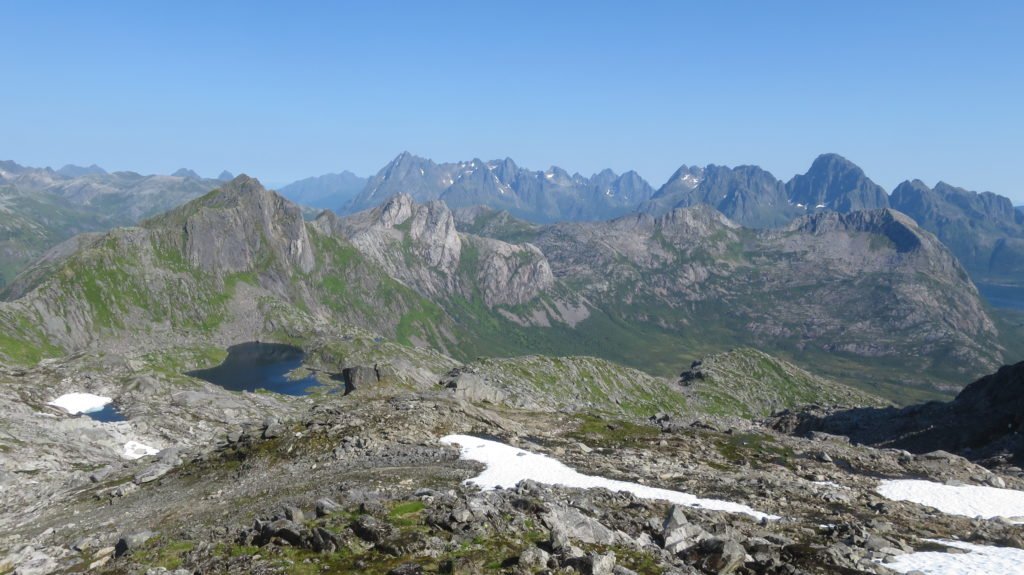
Waking up to clear skies going up high and taking a day off the bike was the right decision, but it was the heatwave, 30+ deg C temperatures and that ever-present sunshine that made the hike and the next night in the tent more challenging than we expected. Rundfjellet means ‘round mountain’, but it still involved some pretty steep scrambly sections to reach the top, but the views were well worth it. We descended to our camp spot to stay another night, and while a campfire kept the mosquitos away, shortly after midnight I saw the full, blood-red moon rising over the rugged peaks, another very memorable moment that will stay with me for a long time.
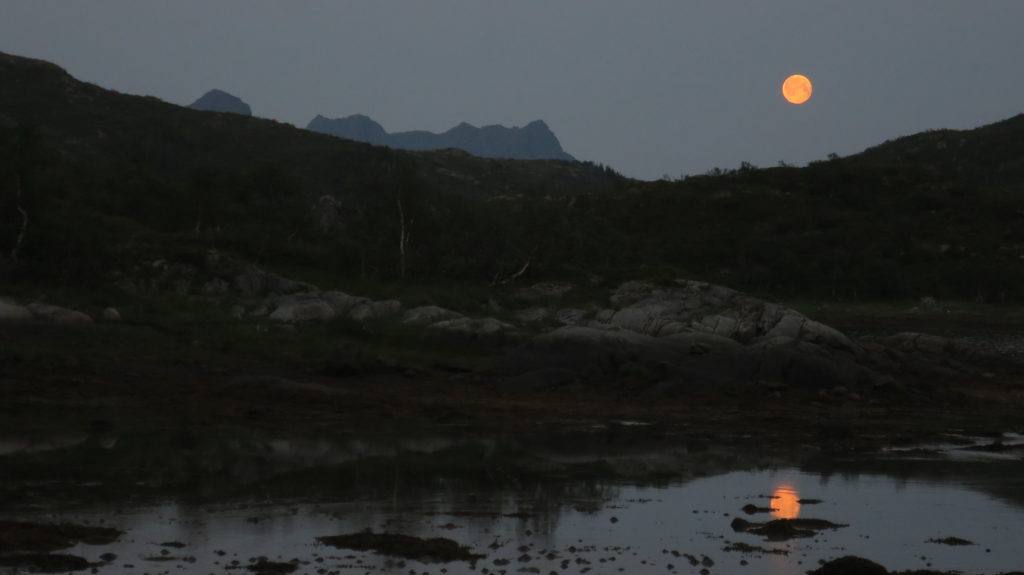
The heat was too much for us and our next stop, Henngisvaer, was far too charming to leave after one night. So, we decided to have a few days rest to enjoy the quirkiness of the fishing village, art and wonderful cafes. Like many Lofoten villages and towns wooden racks can be found all over the place, where the Norwegian Arctic cod are dried from February to June.
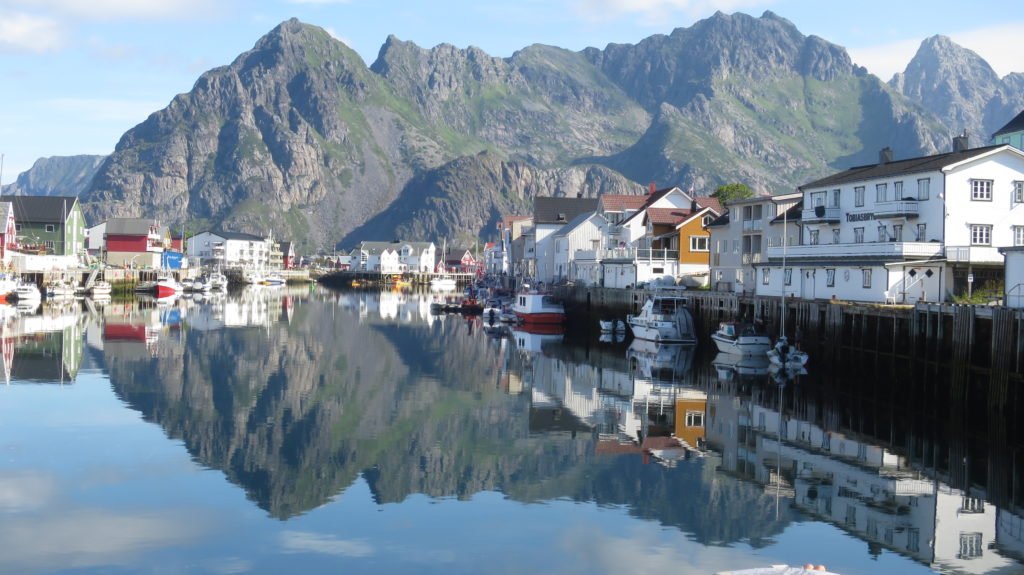
While tourism is playing an ever increasing role in these islands that stretch out into the Norwegian Sea like a row of teeth, the former main industry – fishing – continues to leave a mark in the history of Lofoten. We got to experience this first-hand in the conservation village of Nusfjord, where a former fishing boat turned bike ferry took our tandem and two other bikes across the fjord from Ballstad. It is a beautiful hour long journey along the coast in calm seas with a cheery former fisherman as skipper. In Nusfjord the bright yellow buildings were fun to explore, while breeding sea gulls provided an appropriate soundtrack to dive deep into Norway’s past.
By contrast, later that afternoon we ditched the bike again and hiked into an isolated bay on the northern side of Moskenesøy, only accessible by foot or boat. Kvalvika feels as though it could be at the edge of the world, with turquoise waves crashing on golden sands and vertical cliffs rise into the clouds. Another display of Lofoten at its best.
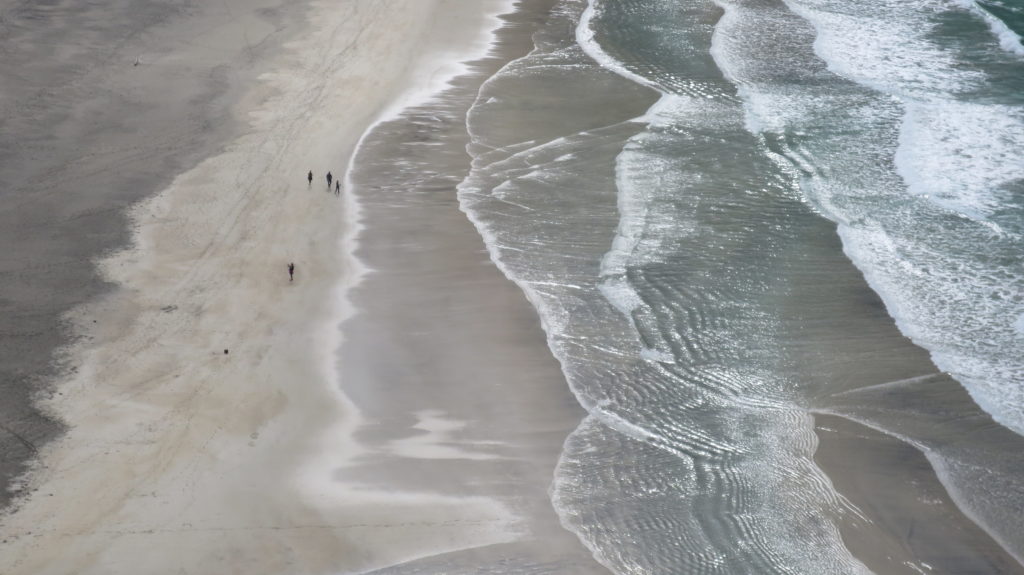
Although our original plan was to leave the tandem at Svolvaer and continue our journey by other means, we both agreed that it was the best mode of transport to experience Norway and decided to keep it for longer. Having been so far north by sailing boat, Kirsty was keen to continue the journey south over the Arctic Circle by human or wind powered means rather than bus or car. We arranged for the bike to be picked up in Nesna, the closest Hurtigruten ferry stop south of the Arctic Circle, from where it would travel back to the hire shop in Tromso.
From Moskenes we travelled by ferry to Bodo, and continued our adventure on the Kystriksveien, the longest of the Norwegian Scenic Routes. Shortly after Bodo we watched the world’s largest tidal maelstrom at Saltstraumen but it was Svartisen, Norway’s second largest glacier, that really caught our attention. While our longest day of the trip, spending 106km in the saddle ended in the initially rather uninspiring village of Glomfjord in the rain, it was the hospitality of the owners of Svartisen Appartments that really stood out and will stay in our memories for much longer.
First of all they arranged a lift through the Svartisen Tunnel for us, as it was closed to cyclists. And if that wasn’t enough, they helped us again 2 days later our freewheel broke and we had to organise a replacement. The closest bike shop was in Ornes, about 35km away from us, but neither hitchhiking or the bus would have got us there during opening hours. After quick phone call to Line Peggy in Glomfjord, her youngest son was dispatched as a taxi and just a few hours later we were on the road again. There were heartfelt thanks from both of us. And passing through Glomfjord that day in the sunshine with food in our bellies made it look far more appealing than our initial impressions.
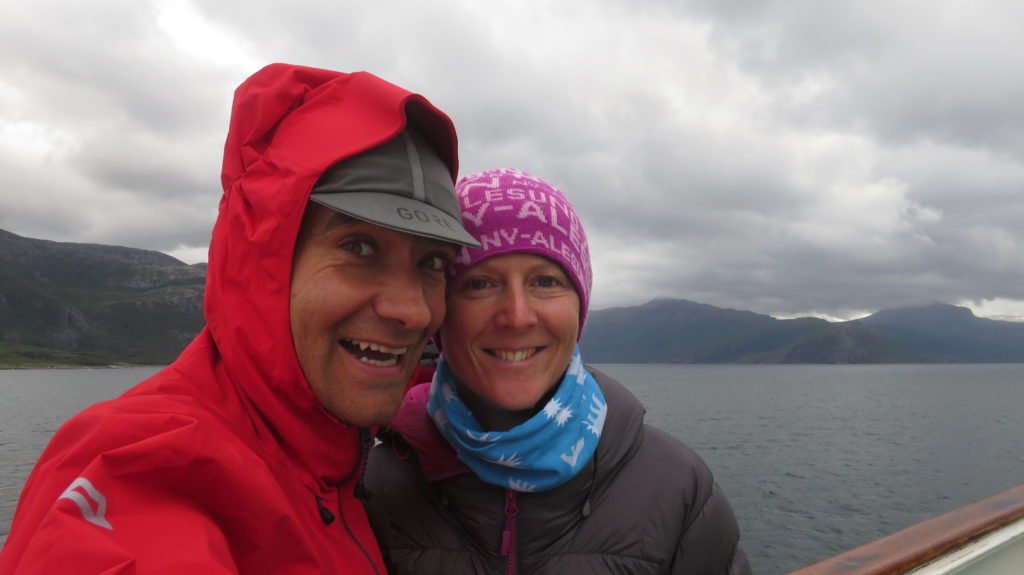
After repairing the bike, we had one more night of camping and the next day we crossed the Arctic Circle at latitude 66 degrees north on the ferry from Jetvik to Kilboghamn. The main journey was over. However, we still had to deliver the bike back so continued with a headwind to the small village of Nesna, waving goodbye sadly to the tandem when we handed it over to the ferryman the next day, before continuing on our journey home via Oslo by bus and train.
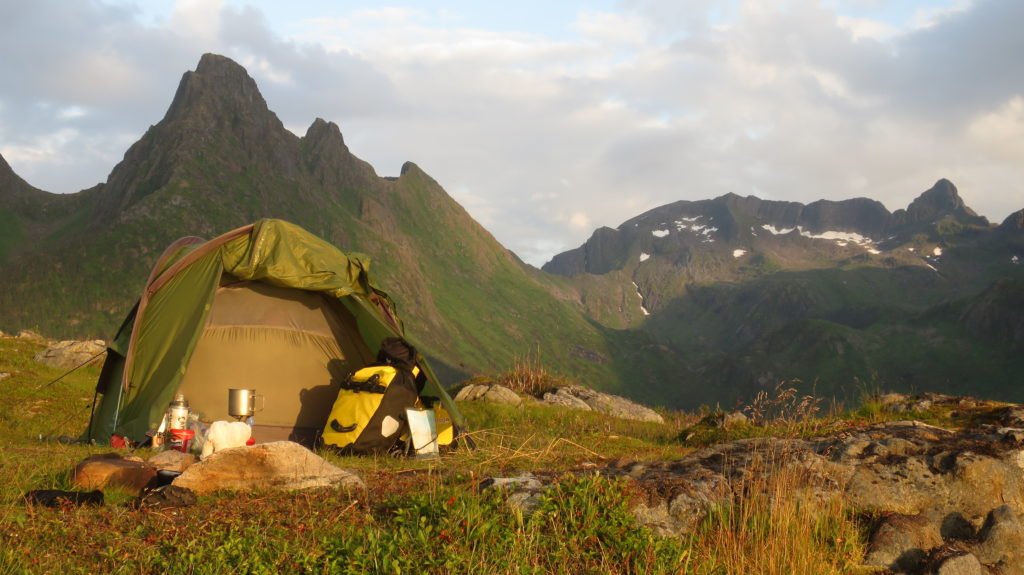
A few practical tips
Wild camping is allowed in open country and not cultivated land in Norway, but campsites with good facilities can also be found frequently along the tourist routes. Other accommodation can be found in form of hostels, hotels and self-catering apartments, but it is wise to book ahead in peak season (July/August). Fresh water is readily available in most places. Most shops and supermarkets are shut on Sundays. Alcohol is very expensive and can only be bought at certain times. Supermarkets sell beer, while wine and spirits are only available in special shops. There are very few bike shops, so bringing some spares is a good idea. Mobile reception is pretty good throughout the country, with 3G available in most places.
By Markus Stitz & Kirsty Maguire
Useful links
Travel Insurance for bike packing
Accommodation suitable for cyclists
More about us